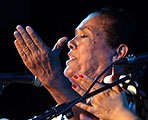17 Bienal de Flamenco
Wednesday, September 4th, 2012. 11:00pm
Special 17th Bienal de Flamenco de Sevilla – All the information
Text: Estela Zatania
Photos: La Bienal
Two flamenco nuns at the convent
Undertakings large and small, expectations equally varied, some legendary artists and some unknown ones, of all ages and origins. The Bienal de Flamenco de Sevilla has that thing, it’s a grab-bag of surprises that you approach with the greatest optimism in search of a reencounter with that certain something which so long along set you on a path few people stray from once the voyage is begun.
Last night, thanks to the good judgment of the organization, and in the face of a disastrous economic situation, the Bienal made a small opening for the arrival of the “duende” all flamenco fans are hungry to experience. It wasn’t an ostentatious presentation. By any stretch. The intimate patio of the Santa Clara convent, with five-hundred years of history, is the perfect setting for a series of recitals titled “Cien Años de Cante”, a hundred years of flamenco singing, with the aim of bringing together tandems of voices, veterans and promising young people, to display the rich panorama of the last century of cante.
Around the end of the seventies, when Lole and Manuel were laying out their original offering, Lole’s family, Los Montoya, made quite a stir with their novel show. As “novel” as it was old, because it was the first time family flamenco by non-professionals had been presented as a “show” on the great stages of Spain and abroad. It was a unique opportunity for armchair flamenco fans to glimpse that kind of flamenco without attending the fiestas, weddings and baptisms normally only open to relatives and friends of the family.
Antonia la Negra is the grand matriarch of the Montoyas. The whole family has been “contaminated” with her wonderfully edgy style and innate flamenco sensitivity. The recital was announced in such a way that you expected to see La Negra, with the brief intervention of her daughter Angelita. But it was quite the opposite. In fact, I’d known and heard Angelita on several occasions over the years, but was in no way prepared for the astonishingly complete recital she was able to pull off last night for the small audience gathered around little round tables in the convent’s cozy patio.
With a surprisingly large repertoire, she began boldly with martinete and debla, and went on to offer a long string of siguiriyas. Her voice is like an implacable trumpet with shading reminiscent of Pastora Pavón whose old house on Calatrava street is just a short walk from the patio. There are also touches of Caracol passed through the prism of Paquera and tinged with irresistible sweetness. No histrionics, plenty of self-assurance. Cantiñas that were half-way between classic and contemporary were embellished with choruses sung by Moi de Morón and Miguel Lavi, and Paco Iglesias was admirable on guitar.
Angelita sang a long set of soleá accompanied por medio and taken at a clip, the typical “Alameda sound” with Triana styles as well. It’s heartening to see a young person so knowledgeable, and able to put it all on the table without hesitation. Tangos were not going to be overlooked, and once again the varied influences that shape this singer were on display. Antonia la Negra appeared towards the end of the tangos dressed in polkadots, more flamenco than flamenco itself, and with a couple of cantes and dance moves put everything right in place. The mother and daughter conjured up the magic of the Familia Montoya’s best years…the choruses, the classic verses, living breathing flamenco, not a museum relic…and that was when I realized my face was aching from smiling such a long time.
Plenty of bulerías to tie everything up…Angelita sang about Pastora and Tomás, Lavi did his little dance…the laidback compás so typical of Seville artists, so different from Jerez, has room for everything and then some…and again, La Negra, physically diminished but with a powerful unamplified voice. Angelita sang to her mother “Me ha parío una gitana de Casablanca” [I was born to a gypsy from Casablanca], they danced together and took their leave amid heartfelt cheering, and it was like the Paris opera, Lincoln Center and the Hollywood Bowl all in one judging from the effusive applause and shouts of praise from the grateful audience.
